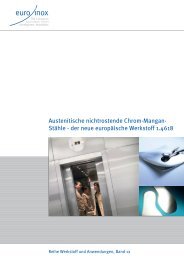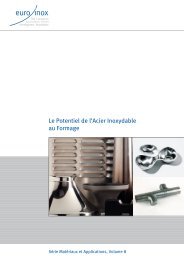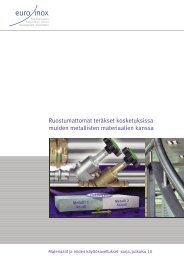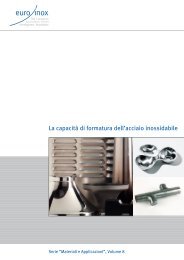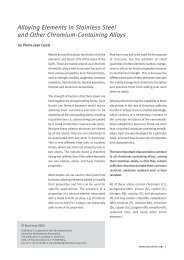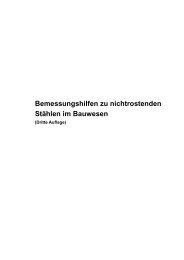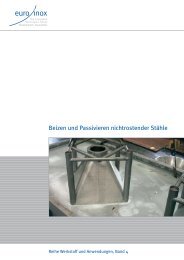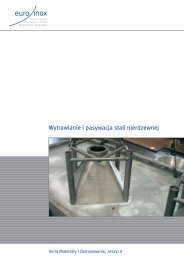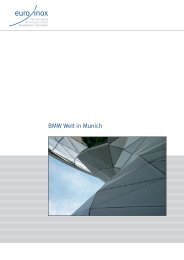Stainless Steel - The Safe Choice - Euro Inox
Stainless Steel - The Safe Choice - Euro Inox
Stainless Steel - The Safe Choice - Euro Inox
Create successful ePaper yourself
Turn your PDF publications into a flip-book with our unique Google optimized e-Paper software.
SAFE STAINLESS STEEL<br />
5.3 <strong>Stainless</strong> steel in contact<br />
with drinking water<br />
Several surveys of performance of stainless<br />
steel in drinking water systems were carried<br />
out from 1997 to 1999. Three types of stainless<br />
steel were used for the pipework simulation<br />
(17) in a cold water system, i.e. stainless<br />
steel X5CrNi18-10/1.4301 containing 18 %<br />
chromium and 10 % nickel, X5CrNiMo17-12-<br />
2/1.4401 containing 17 % chromium, 12 %<br />
nickel and 2 % molybdenum and X2CrMoTi<br />
18-2/1.4521 containing 18 % chromium and<br />
2 % molybdenum.<br />
Electrochemical investigations (18, 19) were<br />
also carried out to compare the stability of<br />
alloys in de-aerated synthetic water at pH 6.6<br />
and at ambient temperature (23°C). <strong>The</strong> composition<br />
of the synthetic water solution was<br />
as follows : Cl- = 200 mg/l, SO 2-<br />
4 = 250 mg/l,<br />
Mg3+ = 50 mg/l, Na + = 150mg/l and K + =<br />
12 mg/l.<br />
<strong>The</strong> results of the electrochemical tests show<br />
the presence of a large passive domain in<br />
which the current density is less than 0.5<br />
µA/cm2 , which implies no corrosion having<br />
taken place.<br />
<strong>The</strong> pipework system (rig system) was designed<br />
to investigate leaching over a period<br />
of several months. Leaching data were obtained<br />
for chromium, molybdenum, iron, titanium,<br />
and the results were as follows:<br />
• Chromium species were detected in the<br />
solution as trivalent chromium (Cr3+ ).<br />
<strong>The</strong> values range from detection limit of<br />
1 µg/l to 2 µg/l. As trivalent chromium was<br />
one of the components of the passive layer,<br />
these values clearly show that the alloys<br />
were in the passive state, implying that no<br />
corrosion occured.<br />
• Molybdenum concentrations were less than<br />
1 µg/l. Molybdenum enhances the properties<br />
of the passive layer and makes all<br />
stainless steels more corrosion resistant,<br />
particularly to pitting in chloride environments.<br />
Pitting corrosion resistance can be<br />
expressed as pitting resistance equivalent<br />
number (PRE), taking into account the role<br />
of chromium and molybdenum, according<br />
to the emperical relationship to predict the<br />
pitting resistance of :<br />
· Ferritic stainless steels :<br />
PRE = % Cr + 3.3 (% Mo)<br />
· Austenitic and duplex stainless steels :<br />
PRE = % Cr + 3.3 (%Mo) + X (%N)<br />
with X = 16 for duplex stainless steels<br />
and X = 30 for austenitic stainless<br />
steels<br />
• Iron, as Fe3+ , is, with chromium, a major<br />
constituent element of the passive film. It<br />
was leached in small quantities (less than<br />
50 µg/l) but release decreased with time.<br />
<strong>The</strong> explanation for the result is that the<br />
passive film is mainly composed of Fe and<br />
Cr oxides and hydroxides and that the Fe<br />
components are less stable than the Cr<br />
components. Thus they are dissolved preferentially.<br />
This leads to a Cr-enrichment<br />
of the passive film and a corresponding<br />
increased corrosion resistance of the material.<br />
© <strong>Euro</strong> <strong>Inox</strong> 2002 www.euro-inox.org · 8



